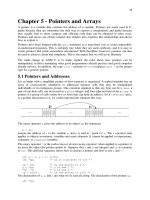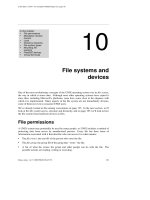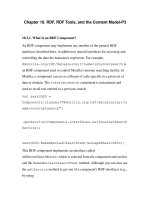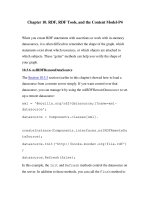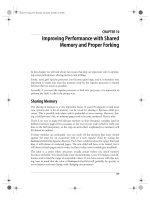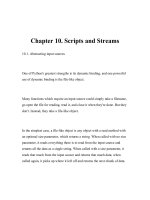Chapter 10 Pointers and Dynamic Arrays potx
Bạn đang xem bản rút gọn của tài liệu. Xem và tải ngay bản đầy đủ của tài liệu tại đây (566.22 KB, 53 trang )
Chapter 10
Pointers and
Dynamic Arrays
Copyright © 2006 Pearson Addison-
Wesley. All rights reserved. 10-2
Learning Objectives
♦
Pointers
♦
Pointer variables
♦
Memory management
♦
Dynamic Arrays
♦
Creating and using
♦
Pointer arithmetic
♦
Classes, Pointers, Dynamic Arrays
♦
The this pointer
♦
Destructors, copy constructors
Copyright © 2006 Pearson Addison-
Wesley. All rights reserved. 10-3
Pointer Introduction
♦
Pointer definition:
♦
Memory address of a variable
♦
Recall: memory divided
♦
Numbered memory locations
♦
Addresses used as name for variable
♦
You’ve used pointers already!
♦
Call-by-reference parameters
♦
Address of actual argument was passed
Copyright © 2006 Pearson Addison-
Wesley. All rights reserved. 10-4
Pointer Variables
♦
Pointers are "typed"
♦
Can store pointer in variable
♦
Not int, double, etc.
♦
Instead: A POINTER to int, double, etc.!
♦
Example:
double *p;
♦
p is declared a "pointer to double" variable
♦
Can hold pointers to variables of type double
♦
Not other types!
Copyright © 2006 Pearson Addison-
Wesley. All rights reserved. 10-5
Declaring Pointer Variables
♦
Pointers declared like other types
♦
Add "*" before variable name
♦
Produces "pointer to" that type
♦
"*" must be before each variable
♦
int *p1, *p2, v1, v2;
♦
p1, p2 hold pointers to int variables
♦
v1, v2 are ordinary int variables
Copyright © 2006 Pearson Addison-
Wesley. All rights reserved. 10-6
Addresses and Numbers
♦
Pointer is an address
♦
Address is an integer
♦
Pointer is NOT an integer!
♦
Not crazy abstraction!
♦
C++ forces pointers be used as
addresses
♦
Cannot be used as numbers
♦
Even though it "is a" number
Copyright © 2006 Pearson Addison-
Wesley. All rights reserved. 10-7
Pointing
♦
Terminology, view
♦
Talk of "pointing", not "addresses"
♦
Pointer variable "points to" ordinary
variable
♦
Leave "address" talk out
♦
Makes visualization clearer
♦
"See" memory references
♦
Arrows
Copyright © 2006 Pearson Addison-
Wesley. All rights reserved. 10-8
Pointing to …
♦
int *p1, *p2, v1, v2;
p1 = &v1;
♦
Sets pointer variable p1 to "point to" int
variable v1
♦
Operator, &
♦
Determines "address of" variable
♦
Read like:
♦
"p1 equals address of v1"
♦
Or "p1 points to v1"
Copyright © 2006 Pearson Addison-
Wesley. All rights reserved. 10-9
Pointing to …
♦
Recall:
int *p1, *p2, v1, v2;
p1 = &v1;
♦
Two ways to refer to v1 now:
♦
Variable v1 itself:
cout << v1;
♦
Via pointer p1:
cout *p1;
♦
Dereference operator, *
♦
Pointer variable "derereferenced"
♦
Means: "Get data that p1 points to"
Copyright © 2006 Pearson Addison-
Wesley. All rights reserved. 10-10
"Pointing to" Example
♦
Consider:
v1 = 0;
p1 = &v1;
*p1 = 42;
cout << v1 << endl;
cout << *p1 << endl;
♦
Produces output:
42
42
♦
p1 and v1 refer to same variable
Copyright © 2006 Pearson Addison-
Wesley. All rights reserved. 10-11
& Operator
♦
The "address of" operator
♦
Also used to specify call-by-reference
parameter
♦
No coincidence!
♦
Recall: call-by-reference parameters pass
"address of" the actual argument
♦
Operator’s two uses are closely related
Copyright © 2006 Pearson Addison-
Wesley. All rights reserved. 10-12
Pointer Assignments
♦
Pointer variables can be "assigned":
int *p1, *p2;
p2 = p1;
♦
Assigns one pointer to another
♦
"Make p2 point to where p1 points"
♦
Do not confuse with:
*p1 = *p2;
♦
Assigns "value pointed to" by p1, to "value
pointed to" by p2
Copyright © 2006 Pearson Addison-
Wesley. All rights reserved. 10-13
Pointer Assignments Graphic:
Display 10.1 Uses of the Assignment
Operator with Pointer Variables
Copyright © 2006 Pearson Addison-
Wesley. All rights reserved. 10-14
The new Operator
♦
Since pointers can refer to variables…
♦
No "real" need to have a standard identifier
♦
Can dynamically allocate variables
♦
Operator new creates variables
♦
No identifiers to refer to them
♦
Just a pointer!
♦
p1 = new int;
♦
Creates new "nameless" variable, and
assigns p1 to "point to" it
♦
Can access with *p1
♦
Use just like ordinary variable
Copyright © 2006 Pearson Addison-
Wesley. All rights reserved. 10-15
Basic Pointer Manipulations Example:
Display 10.2 Basic Pointer
Manipulations (1 of 2)
Copyright © 2006 Pearson Addison-
Wesley. All rights reserved. 10-16
Basic Pointer Manipulations Example:
Display 10.2 Basic Pointer
Manipulations (2 of 2)
Copyright © 2006 Pearson Addison-
Wesley. All rights reserved. 10-17
Basic Pointer
Manipulations
Graphic:
Display 10.3
Explanation of
Display 10.2
Copyright © 2006 Pearson Addison-
Wesley. All rights reserved. 10-18
More on new Operator
♦
Creates new dynamic variable
♦
Returns pointer to the new variable
♦
If type is class type:
♦
Constructor is called for new object
♦
Can invoke different constructor with
initializer arguments:
MyClass *mcPtr;
mcPtr = new MyClass(32.0, 17);
♦
Can still initialize non-class types:
int *n;
n = new int(17); //Initializes *n to 17
Copyright © 2006 Pearson Addison-
Wesley. All rights reserved. 10-19
Pointers and Functions
♦
Pointers are full-fledged types
♦
Can be used just like other types
♦
Can be function parameters
♦
Can be returned from functions
♦
Example:
int* findOtherPointer(int* p);
♦
This function declaration:
♦
Has "pointer to an int" parameter
♦
Returns "pointer to an int" variable
Copyright © 2006 Pearson Addison-
Wesley. All rights reserved. 10-20
Memory Management
♦
Heap
♦
Also called "freestore"
♦
Reserved for dynamically-allocated variables
♦
All new dynamic variables consume memory
in freestore
♦
If too many could use all freestore memory
♦
Future "new" operations will fail if freestore
is "full"
Copyright © 2006 Pearson Addison-
Wesley. All rights reserved. 10-21
Checking new Success
♦
Older compilers:
♦
Test if null returned by call to new:
int *p;
p = new int;
if (p == NULL)
{
cout << "Error: Insufficient memory.\n";
exit(1);
}
♦
If new succeeded, program continues
Copyright © 2006 Pearson Addison-
Wesley. All rights reserved. 10-22
new Success – New Compiler
♦
Newer compilers:
♦
If new operation fails:
♦
Program terminates automatically
♦
Produces error message
♦
Still good practice to use NULL check
Copyright © 2006 Pearson Addison-
Wesley. All rights reserved. 10-23
Freestore Size
♦
Varies with implementations
♦
Typically large
♦
Most programs won’t use all memory
♦
Memory management
♦
Still good practice
♦
Solid software engineering principle
♦
Memory IS finite
♦
Regardless of how much there is!
Copyright © 2006 Pearson Addison-
Wesley. All rights reserved. 10-24
delete Operator
♦
De-allocate dynamic memory
♦
When no longer needed
♦
Returns memory to freestore
♦
Example:
int *p;
p = new int(5);
… //Some processing…
delete p;
♦
De-allocates dynamic memory "pointed to by
pointer p"
♦
Literally "destroys" memory
Copyright © 2006 Pearson Addison-
Wesley. All rights reserved. 10-25
Dangling Pointers
♦
delete p;
♦
Destroys dynamic memory
♦
But p still points there!
♦
Called "dangling pointer"
♦
If p is then dereferenced ( *p )
♦
Unpredicatable results!
♦
Often disastrous!
♦
Avoid dangling pointers
♦
Assign pointer to NULL after delete:
delete p;
p = NULL;
